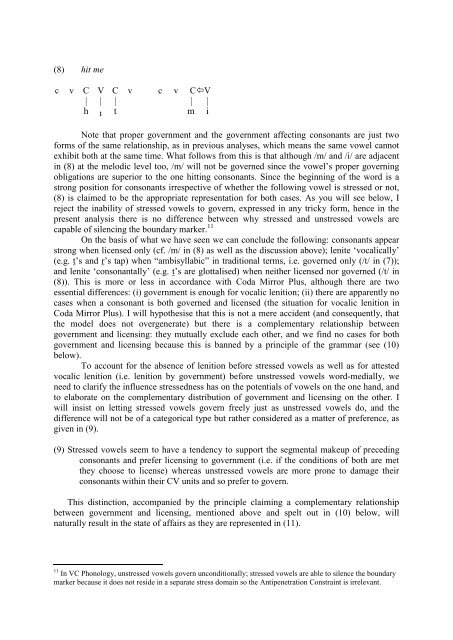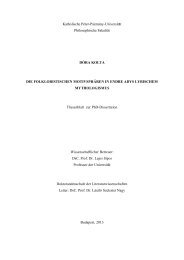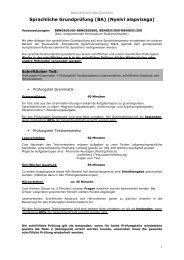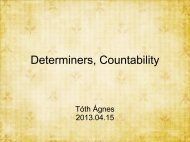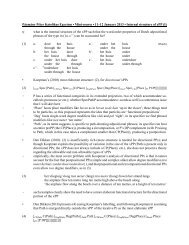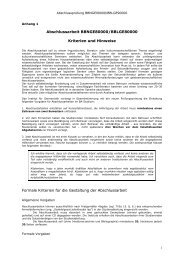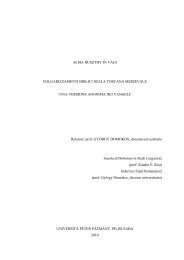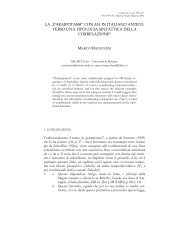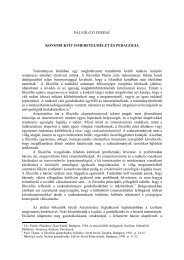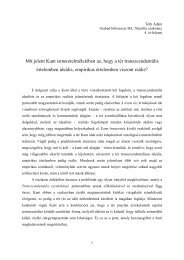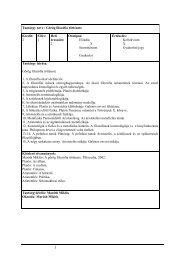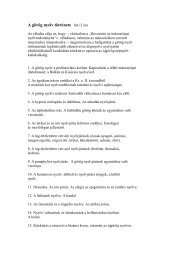“Ambisyllabicity” across word boundaries:
“Ambisyllabicity” across word boundaries:
“Ambisyllabicity” across word boundaries:
You also want an ePaper? Increase the reach of your titles
YUMPU automatically turns print PDFs into web optimized ePapers that Google loves.
(8) hit me<br />
c v C V C v c v CV<br />
| | | | |<br />
h t m i<br />
Note that proper government and the government affecting consonants are just two<br />
forms of the same relationship, as in previous analyses, which means the same vowel cannot<br />
exhibit both at the same time. What follows from this is that although /m/ and /i/ are adjacent<br />
in (8) at the melodic level too, /m/ will not be governed since the vowel’s proper governing<br />
obligations are superior to the one hitting consonants. Since the beginning of the <strong>word</strong> is a<br />
strong position for consonants irrespective of whether the following vowel is stressed or not,<br />
(8) is claimed to be the appropriate representation for both cases. As you will see below, I<br />
reject the inability of stressed vowels to govern, expressed in any tricky form, hence in the<br />
present analysis there is no difference between why stressed and unstressed vowels are<br />
capable of silencing the boundary marker. 11<br />
On the basis of what we have seen we can conclude the following: consonants appear<br />
strong when licensed only (cf. /m/ in (8) as well as the discussion above); lenite ‘vocalically’<br />
(e.g. t’s and r’s tap) when “ambisyllabic” in traditional terms, i.e. governed only (/t/ in (7));<br />
and lenite ‘consonantally’ (e.g. t’s are glottalised) when neither licensed nor governed (/t/ in<br />
(8)). This is more or less in accordance with Coda Mirror Plus, although there are two<br />
essential differences: (i) government is enough for vocalic lenition; (ii) there are apparently no<br />
cases when a consonant is both governed and licensed (the situation for vocalic lenition in<br />
Coda Mirror Plus). I will hypothesise that this is not a mere accident (and consequently, that<br />
the model does not overgenerate) but there is a complementary relationship between<br />
government and licensing: they mutually exclude each other, and we find no cases for both<br />
government and licensing because this is banned by a principle of the grammar (see (10)<br />
below).<br />
To account for the absence of lenition before stressed vowels as well as for attested<br />
vocalic lenition (i.e. lenition by government) before unstressed vowels <strong>word</strong>-medially, we<br />
need to clarify the influence stressedness has on the potentials of vowels on the one hand, and<br />
to elaborate on the complementary distribution of government and licensing on the other. I<br />
will insist on letting stressed vowels govern freely just as unstressed vowels do, and the<br />
difference will not be of a categorical type but rather considered as a matter of preference, as<br />
given in (9).<br />
(9) Stressed vowels seem to have a tendency to support the segmental makeup of preceding<br />
consonants and prefer licensing to government (i.e. if the conditions of both are met<br />
they choose to license) whereas unstressed vowels are more prone to damage their<br />
consonants within their CV units and so prefer to govern.<br />
This distinction, accompanied by the principle claiming a complementary relationship<br />
between government and licensing, mentioned above and spelt out in (10) below, will<br />
naturally result in the state of affairs as they are represented in (11).<br />
11 In VC Phonology, unstressed vowels govern unconditionally; stressed vowels are able to silence the boundary<br />
marker because it does not reside in a separate stress domain so the Antipenetration Constraint is irrelevant.


